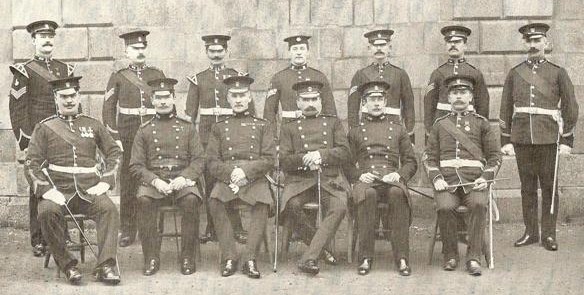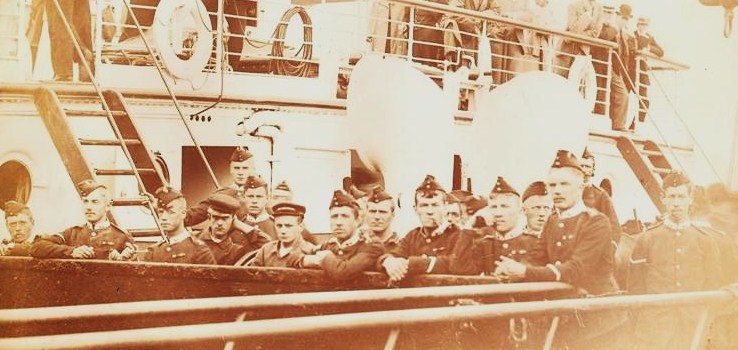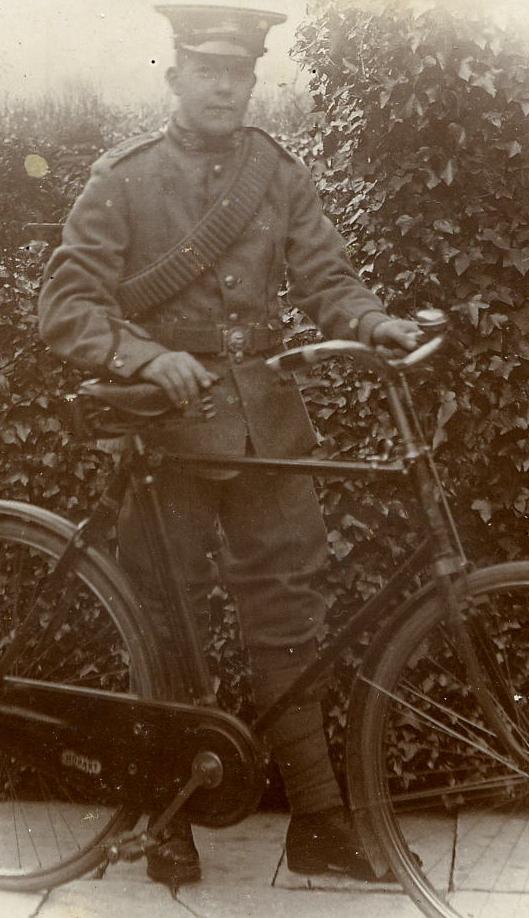-
Posts
1,065 -
Joined
-
Last visited
-
Days Won
1
Content Type
Profiles
Forums
Blogs
Gallery
Events
Store
Posts posted by Graham Stewart
-
-

Senior NCO's and Officers 4th Bn, Northumberland Fusiliers 1904 clearly showing the new pattern scarlet jacket and new pointed cuff, which in they case of senior NCO's is trimmed with gold lace.
0 -

At last, although cut down considerably - 1st Bn, NF on the boat for South Africa, 1899 with their frock coats still displaying white collars.
0 -
"The Childers Reforms restructured the infantry regiments of the British army. The reforms were undertaken by Secretary of State for War Hugh Childers in 1881, and were a continuation of the earlier Cardwell reforms."
I'm afraid I'm always suspect of these sites where in my opinion bits and piecs are taken from various sources which are then clubbed together and then become gospel. It's like the above copied first statement because as far as I'm aware it was Cardwell who was the brainchild behind "territorialisation" and thats what most of our histories quote, even down to pariamentry discussion. I have a brilliant academic history at home on the Victorian Army by a modern author which covers all of this.
As for the Northumberlands they certainly didn't have gosling green facings in 1899. I've been trying to post a photo here showing the 1st Bn, on the boat for South Africa in their frock coats complete with white facings. The following volume for 1900 of the regimental journal celebrates the return of the facings with a coloured plate to that effect, but it wasn't immediate and was slowly introduced both to the 3rd and 4th Bn's. As mentioned in my last post by the time the 1st and 2nd Bn's returned to the UK, the new pattern tunic with pointed cuff was already on it's way into universal wear at home.
0 -
Apologies for my error in stating c.1902, as it was in that year that the new jacket was introduced with the pointed cuff. As far as I'm aware the Northumberland Fusiliers certainly didn't regain their facings in 1899, as I have the regimental journal for that year and no mention or illustration shows them in wear. If my memory is correct it's the journal for 1900 that mentions and shows the restoration of the facings, but only by the 3rd and 4th Battalions as by then both the 1st & 2nd Bn's were serving in South Africa. I think I would be also correct in saying that it wasn't until 1903 that they actually saw their old facings, but by then the new pattern tunic had been introduced. However all all of my stuff is thousands of miles away and I'm going purely off memory.
0 -
Facings as far as I'm aware under the 1881 Reforms, which were actually constituted by Cardwell and finished by Childers and are always known as the "Cardwell Reforms", were blue for Royal Regiments, this included the Guards, "Royal" Scottish and Irish regiments. White for non-Royal English and Welsh, green for non-Royal Irish and Yellow for non-Royal Scottish. The re-introduction of facings from my own studies and from photographs I've seen didn't make a re-appearance until c.1902.
However what you have to remember that this may not have included units then currently on the Indian establishment as British units in India wore a different pattern of scarlet jacket while in service there, which may have re-introduced facings earlier than the home units.
0 -
Award for the M.C. appears in the Supplement of the London Gazette for the 1st January 1917, but for what is not recorded. Now if I remember correctly all Guards Service records remain in the custody of the Guards and not at the National Archive, (unless of course Guards Officers records were placed there). Often in such records can be found the citation for the award.
0 -
Capt Gibbs should appear in the Army List and personally I would start with Lists from 1900 working both ways.
0 -
Nice one Noor - R.A.S.C. is indeed the Royal Army Service Corps and the 'W.O.CL II' stands for 'Warrant Officer Class II'.
0 -
Like Leigh I'm at a loss and find it a really unusual helmet. I think what has us baffled is why should the Cameronians(a Rifle Regt) have a Rifle green FS helmet whereas I think that all the other Rifle Regt's to serve in India seemingly complied with dress regs and had the normal two FSH for wear - one in khaki and one in white???
Did the Cameronians do as Leigh suggests possibly place a special order for a helmet for wear by the band only and if so where was the order placed and with whom? Is it the basic HSH made to look like an FSH or an FSH dyed with the addition of black leather edging to give it a Rifle look?? I just don't know, but it's still a lovely photo and has been a good talking point.
0 -
The apparent absence of any holes, either for the crosspiece or the helmet plate, indicates either that the helmet is a FSH or a HSH direct from stores. Here I am assuming for the latter that the furniture and plate would have been added by the regimental tailor or armourer.
The 1st Battalion were in India 1894-1909, four years after the HSH was discontinued for them, and the 2nd Battalion were in India 1881-1895 so unlikely that they ever had the HSH.
I give in. This one is too hard. I don't know how or why he has such a helmet but I still think it is a FSH.
Puggarees were always bulky towards the bottom, that is the nature of the beast when many pleats are required. Puggarees could be up to 24ft (7.4m) long so no wonder they could be bulky.
Anyone got another dead horse to flog

Stuart
This is the beauty of such a site as this, where we are able to view and comment on such unusual photo's as this. Unfortunately as far as the British Army in India goes it's a minefield of the unusual and leaves us members with years of collecting, research and knowledge scratching our heads when such oddments come along.
For some more stunning photo's of our Army in India, I recommend that you visit the link/website mentioned in my earlier post entitled "Soldiers of the Queen".
0 -
Graham,
this is a bit off topic but in one of my references I found that the red cloth 'V' section worn above the puggaree by the Northumberland Fusiliers was officially sanctioned by the War Office on 23rd October 1903.
If you like I can attempt to get more details as I know the author of this reference.
I presume that the NFs with this helmet would have worn a khaki cover to provide camouflage during the 2nd Boer War.
Stuart
I'm going purely off memory here as all my files are at home, but the first reference to the 'V' appears in the regimental "Digest of Service" and it was being worn in India long before 1903 and photo's show it worn during the Black Mountain Expedition. The reference to it came as a letter of sanction from the Governor General of India, which I'm sure pre-dates the WO by some years. Does your reference come from Denis Woods book?
0 -

probably to small to see, but there is an object attached to the uniform which isn't part of the sofa or curtain background. In my original post I said it was surely the drummers badge, but on reflection it should be on the upper arm and not lower, so am now wondering what this is.
Stuart - the helmet is a curiosity and I'm sure the edging here appears to be black(?) leather due to the sheen and would comply with materials used by Rifle regiments. Had it been of the same material like other FSH edging it would have blended in more easily.
India itself appears to a minefield regarding uniform and dress, with unusual items appearing. Ironically the red cloth 'V' section worn above the pagree by the Northumberland Fusiliers and a regular feature throught their history was itself only sactioned in India and not through the War Office.
0 -
Again another unusual pattern KD jacket as described by Leigh, with the pockets being the unusual feature, with the double button. His bugle cords are dark green as were all bugle cords of non-royal regiments, but in the case he appears to be a drummer. A closer look at the lower sleeve of his left arm when blown up shows an additional attached item, which is surely the worsted drum in dark green cotton.
The helmet too is of an interesting pattern and actually looks like a Home Service pattern helmet, based on the strengthening feature around the outer edge, with a pagree fitted, all in Rifle green. The white metal badge I've seen on numerous occasions at militaria fairs, but was unaware that it was also worn with the pagree.
For one of the best websites depicting soldiers during this period visit "Soldiers of the Queen" at this link;-
http://www.soldiersofthequeen.com/
0 -

Hope the lads from GWF don't mind me showing you this one, but as you will see another unusual pattern of jacket complete with buttoned cuff.
0 -
I was wondering if the combination was a foible of the IOGT members at their lodge meetings, or if the jacket is adapted for the purpose, with that box pleat running the length of the front. A little fanciful, but I even considered the jacket being in red, but the presseing makes it appear KD rather than serge or whatever.
I would say definately KD, as the scarlet Indian pattern jackets are usually to be found with trefoil braiding on the cuff, white piping on the collar etc and coloured facings not unlike home pattern uniforms. This particular KD jacket is different though. Firstly the box pleats to the front as you've mentioned, but also the cuff, as I don't recall seeing a KD jacket with a double button or any buttons on the cuff at all.
Now this is the second jacket I've seen over the last couple of weeks which is of a totally different pattern to what I would expect to see. The other jacket was being worn by a cyclist of a Somerset L.I. Volunteer Battalion. It too had an unusual cuff and was also buttoned. So I'm beginning to wonder if this lad had some 'specialist' trade within the battalion which saw them wearing unusual KD jackets??
0 -
Very nice and best of luck getting the Commonwealth stuff together. As an after thought should the current Military Provost Guard Force(?) also be included?? Although uniformed, badged and administered by the Military Provost they are in effect a civilian(all ex-military) outfit carrying out guard duties throughout the UK and eliminating the problem of units having to supply guards for camps and bases, when they would be better off doing other things.
0 -
The photo does have uniform anomalies, not normally found even for India. Firstly KD jacket with the blue dress trousers, when the KD trousers should have been in evidence. The white dress helmet would never be worn with KD - with blues and review order but certainly not KD - as the khaki foreign service helmet or field service cap would be worn with KD. So you have to ask is this a posed photo taken after a major parade hence him dressed in items of uniform which don't meet dress reg's??
0 -
Lovely clear photo of a Sgt Major of the AOC, hence the addition of gold lace to the collar.
0 -
Very nice - I have seen a number of this type of photo for various regiments and wonder if they are all associated with the Army Temperance Association of which I also have a medal somewhere at home. Again nearly all of the photo's I have seen have been taken in India.
0 -
Merv - superb reference material here. I take it that the reference to the "plates being destroyed" must be the "printers plates". Hopefully the original artwork survived and is residing in the RA Museum, as it would be a sad loss indeed if they too were destroyed.
Hugh,
Guess you must be a Yank and ex-US Navy. The "Zulu Warrior" is a traditional British service dance, performed when totally out of your head with grog and usually performed in foreign ports. The principle participant/victim is usually to be found at the loftiest spot being urged on by his shipmates/service colleagues singing "Haul'em down you Zulu Warrior, Haul'em down you Zulu Chief - Chief - Chief" etc, etc. Best I ever saw was performed on the top of the PX at the U.S.Naval Base in Puerto Rico. Oh! almost fogot the individual concerned is always bollock naked at the end dancing around like a lunatic.
0 -
Problem with this is that this particular form of dress was also extended to the Miltia and Volunteer Infantry of the period. However if she has a name then Army/Militia Lists(if they exist) for the period may could help.
0 -
The infantry had two types of scarlet one being for "best" or review order, while the frock coat, which was of a different pattern was for general everyday wear. Perhaps the cavalry was no different in this respect?
0 -
You'll have to take a photo of your frock coat and try and post it to give us a better idea of what it looks like. Going back to those Yeomanry books mentioned in my last post it would appear that their were at least 10 in the series, all containing coloured and b&w period illustrations.
I've also been racking my brains as to where you'd find other illustrations and the only thing I can think of, where the cavalry featured was a magazine produced in the 1890's called the "Navy & Army Illustrated". The photographic illustrations in it are superb for the period, but as you can guess it would be easier to come across rocking horse sh*t, than copies of this magazine, which ran to a few volumes. The last bound volume set I came across retailed at over a £1,000.
0 -

One of the Yeomanry books illustrated by Bob Marrion.
0




Tunic Facings
in Great Britain: Militaria: Badges, Uniforms & Equipment
Posted
Stuart I have to agree that poor old Childers seems to get little credit for completing Cardwell's work, but politics works in mysterious ways to us laymen and alas he remains unrecognised. When I'm next at home I'll send you the title and author of the book I referred to earlier. Even though an academic work it was well written and a pleasure to read.
As for the NF sadly being stuck here means a lot of my responses are done from memory, when really I could do with all of my notes and books being to hand. Age doesn't help either as at coming up to 56 this year and the old grey matter just doesn't seem to hold what it once did. :beer: